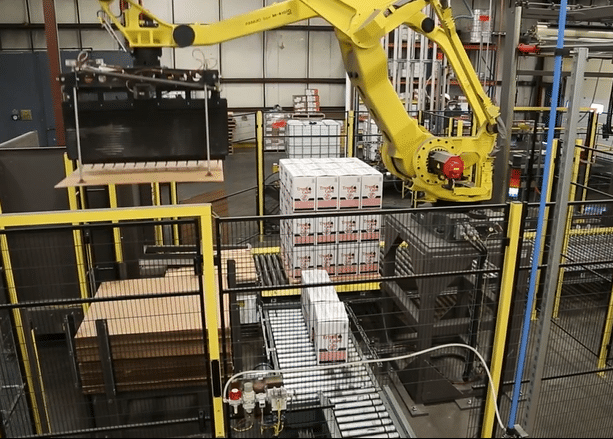
In recent years, there has been a growing demand for automated solutions to improve efficiency and reduce manufacturing and logistics operations costs. One such technology that has gained popularity is palletizing robots, which can significantly streamline the process of stacking and arranging goods on pallets.
What are Palletizing Robots?
Palletizing robots are designed to automate palletizing, making the necessary task safer and more efficient. Robotic palletizers use sensors and machine vision technology to identify the location and orientation of items. They use gripping mechanisms, known as end-of-arm tooling (EOAT) to pick up and place the items on the pallet, which offers businesses a wide range of versatility that enable the robot to handle, boxes, bags, cartons, drums, and other products, and can stack them in a variety of configurations to optimize the use of space on the pallet.
Benefits of Palletizing Robots
There are several key benefits of using palletizing robots in manufacturing and logistics operations:
- Improved efficiency: Palletizing robots can work continuously without breaks, which can significantly increase productivity and throughput. They can also palletize goods much faster than human workers, reducing cycle times and improving overall efficiency.
- Reduced labor costs: By automating the palletizing process, companies can reduce their reliance on human workers, which can help reduce labor costs and improve profitability. Palletizing robots can also reduce the risk of injury from lifting heavy objects, which can help to lower workers’ compensation costs.
- Improved safety: Palletizing robots are equipped with advanced safety features, such as sensors and protective barriers, which can reduce the risk of accidents and injuries. This can help to improve overall safety in the workplace and create a more positive work environment.
- Increased accuracy: Palletizing robots can accurately stack goods in a specific order, which can help to reduce the risk of damage during transportation. This can help to improve customer satisfaction and reduce the need for costly returns or replacements.
- Greater flexibility: Palletizing robots can handle a wide range of items and can stack them in a variety of configurations, which can help to optimize the use of space on the pallet. This can help to reduce shipping costs and improve overall efficiency in the supply chain.
Applications of Palletizing Robots
Palletizing robots are used in a variety of applications and industries. Some of the most common applications include:
- Food and beverage industry: Designed to work in cleanrooms and extreme temperature environments, the food and beverage industry uses a variety of containers such as bottles, cans, and cartons. Robotic palletizers handle fragile items with care, ensuring that they are stacked in a way that minimizes the risk of damage to heavy bulky items.
- Consumer goods industry: Palletizing robots are used in the consumer goods industry to palletize items such as boxes, bags, and containers. They can handle a wide range of items simultaneously, making them highly versatile and efficient.
- Manufacturing: With the ability to work continuously, Palletizing robots are becoming increasingly popular in manufacturing plants. From stacking finished products on pallets, to palletizing raw materials or components for production, manufacturers are reaping the benefits of increased production, fewer work-related injuries, and consistency in quality.
- Logistics and distribution centers: Programmed to arrange and stack a wide variety of products for shipping and transportation, they can optimize the use of space on the pallet, reducing shipping costs and improving overall efficiency in the supply chain.
The type of robotic palletizer that is best suited for a particular application will depend on a range of factors, including the size and weight of the products being handled, the available workspace, and the desired level of automation. Before integrating a robotic palletizer, it is important to evaluate the current operations and identify areas where the palletizer could improve efficiency. Working with the right robotic integrator can make a big difference in the success of your palletizing project.
Look for an integrator who designs, engineers, install, and maintains your palletizing system. A partner who is versed in your industry and has a full understanding of your goals, and can bring all of the components of your palletizing system together, will save you valuable time and money. RMH Systems is your one-source integrator for your warehouse. Schedule a free consultation with our team to see how robotics can help address your business challenges and help you grow.